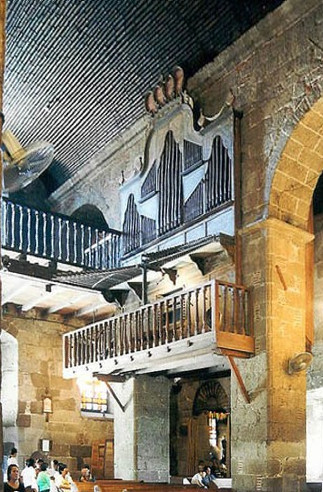This article features the unusual Las Piñas bamboo organ stamps from the Philippines. Pipe organs are among the most prevalent specific instruments that appear on stamps. In other words, while other stamps might feature a generic violin, a generic guitar, or a generic piano, stamps with organs feature very specific instruments. In addition, organs are usually very large and expensive and custom built for a specific church. Finally, pipe organs can be in use for several centuries, making them well known symbols. Accordingly, organs often become symbols of pride for a specific church, community, or even country.
A great resource about organ stamps is the Pipe Organs of the World on Postage Stamps blog by Michael R. Barker. Further, this site features organ postage stamps from Austria, Mexico, Germany, and Belgium, among others.
Las Piñas Bamboo Organ

The Spanish priest Father Diego Cera was the parish priest of the City Las Piñas in the capital region of the Philippines from 1795 until 1830. The community of faithful catholics grew under his leadership until in the middle of the 1810s, they were in need of a new church building. A polyglot, the priest led in the construction of the church. In addition, having studied organ building in Manilla, he also set out to build an instrument for the church.
Father Cera began working on the organ in 1816, and, surprisingly, chose bamboo as the material for the pipes. This was probably because of its practicality and affordability as bamboo grows plentifully in the region. However, the trumpet pipes are of metal. It took until 1824 for the instrument to be completed.
The case of the instrument is also unusual. It has a wood facade of a crown on top of the organ and red velvet drapes falling across the ranks of exterior pipes. Further, the entire instrument sits in an organ loft above the congregation.
Modern History
Due to the fragility of bamboo pipes, the instrument has undergone many restorations, beginning even during Cera’s lifetime. In 1973, it was decided that the instrument needed to be completely renovated. The firm of Johannes Klais Orgelbau was chosen to do the work, specifically because of their reputation restoring historic Spanish instruments. The instrument was completely removed from the church and the bamboo pipes were shipped to a workshop in Japan while the other pieces of the instruments went to the workshop in Bonn.
In 2003, the National Museum of the Philippines declared the Las Piñas bamboo organ as a “National Cultural Treasure.” Since 1994, the care of the instrument is by the Diego Cera Organbuilders, incorporated. It is the first Filipino organ building company and has the mission of caring for this special instrument. Finally, in 2019, Google created a special “doodle” honoring the 195th anniversary of this amazing instrument.
Stop List
| Mano Yzquierda (bass) FF-c1 | Mano Derecha (treble) c#1-f3 | Pedal FF-E (12 notes) |
| Flautado violin 8′ | Flautado violin 16′ | Contras (II) 4′ |
| Flautado major 4′ | Flautado major 8′ | |
| Octava 1o 2′ | Travizera (II, beating) 8′ | |
| Octava 2o 2′ | Octava 1o 4′ | Accessory stops |
| Docena 1o 11/3′ | Octava 2o 4′ | Pajaritos (bird song, 7 pipes) |
| Docena 2o 11/3′ | Otavina 4′ | Tambor (“drums”, 2 pipes) |
| Quincena 1o 1′ | Docena 1o + 2o (II) 22/3′ | |
| Quincena 2o 1′ | Quincena 1o + 2o (II) 2′ | |
| Bajoncillo (chamade) 4′ | Corneta (mounted, V) 8′ | |
| Clarin campana 2′ (chamade) | Clarin claro (chamade) 8′ | |
| Clarin campana 8′ (chamade) |
The Stamps

Scott Numbers: PH 903; 904; and 905
A set of three postage stamps featuring the Las Piñas organ became available on May 4, 1964. Indeed, each of the three stamps has a different value, 5 sentimos, 6 sentimos, and 20 sentimos. In addition, each is a different color: yellow-green, orange, and bright green. The design for each stamp, however, is the same. They show the organ case from the front, with the bamboo pipes and the unusual facade. The second stamp, unusually, was re-issued in 1971 with a overprinted surcharge (I do not have in my collection).
I bet you can hardly wait to hear this unusual instrument! It actually sounds quite wonderful and not unlike other pipe organs. Enjoy:


Fascinating, Jay. Hadn’t heard about this organ or the stamps before. Thanks for the writeup.
Thanks, Ted! It is indeed a fascinating instrument that I only learned about because of the stamps.